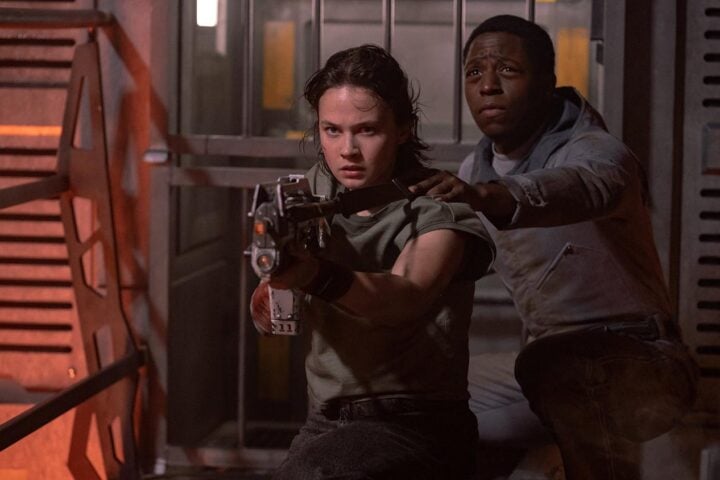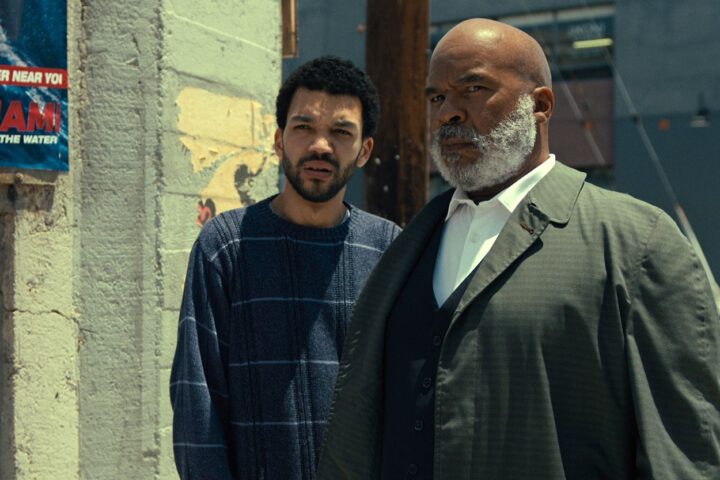The scariest part of writer-director Alex Garland’s Civil War is how normal it all feels. Hoteliers warn their guests that power outages caused by a suicide bombing down the block may make climbing 10 flights a safer option than taking the elevator. Stopping for gas is a game with a 50/50 chance of leaving with a full tank or losing your life. Small-town dress shops conduct business as usual in the shadows of rooftop-perched snipers.
Best known for high-concept science fiction and horror, this isn’t the film that anyone would have expected Garland to make. The writer-director of Ex Machina, Annihilation, and Men, Garland eschews the mind-bending big ideas of his previous work, including the FX series Devs, for an urgent, breathless immediacy: placing war correspondents as the “heroes” at the center of a blisteringly real American apocalypse. Frightening, even-tempered, and disarmingly humane, Civil War is intelligent precision filmmaking trained on an impossible subject.
In the waning days of the second American Civil War, Lee (Kirsten Dunst), a disillusioned photojournalist, hopes to make it from New York City to Washington, D.C. to document the fall of the nation’s capital to the “Western Forces,” an alliance between California and Texas engaged in open rebellion against the federal government. At the same time, the “Florida Alliance,” which is attempting to overthrow other areas of the country, is also closing in.
Lee is joined on her journey by adrenaline junkie Joel (Wagner Moura), elderly mentor Sammy (Stephen McKinley Henderson), and Jesse (Cailee Spaeny), an ambitious young combat photographer who tags along despite Lee’s protestations. As the foursome make their way across the treacherous highways and byways of an eerily empty eastern U.S. landscape, Lee does her best to teach Jesse what it means to do what she does in a country that’s become indistinguishable from the war zones that she’s made a career out of covering abroad.
It’s tempting to see Lee, given the way she has her eye on a world superpower on the brink, as a sort of proxy for Garland himself. “Every time I survived a war zone, I thought I was sending a warning home: Don’t do this,” she says to Sammy. “But here we are.” Garland has similarly captured a taste of what armed conflict of this magnitude might look like on U.S. soil presenting it to viewers, not as a conceptual exercise, but as close to a visceral reality as possible.
Civil War is a marked departure for Garland, who forgoes tracks and dollies for state-of-the-art handheld self-stabilizing cameras that, as he’s put it, behave “weirdly like the human head” and see as we do. In addition, the use of full flash blanks for the gunplay and an attention to sharply choreographed tactical accuracy in the film’s most pulse-pounding sequences make the chaos and bloodshed of Civil War feel more real than real: a successor to rival the immersive cinematic warfare that Kathryn Bigelow revolutionized in previous decades.
But it’s in the moments when the film breaks with its own verité style that Garland’s anti-war messaging is most clearly defined. Hyper-aware of the romanticizing and intoxicating aspects of many war films, the filmmaker uses carefully curated needle drops, lyrical slow-mo passages, and silent, still inserts of violent encounters to break up tension and create a flattening, distancing, or ironic counterpoint to the fibrous mayhem he so expertly crafts outside of these moments—transposing the ghoulish excitement of action cinema or visualizing the moment-to-moment passing of images from bleeding reality into a historic remove.
Garland’s script plays coy with the events that lead to the conflict at the center of Civil War and the approach largely works. The seemingly far-fetched reality of a red-state/blue-state alliance is a provocative question without answer in a film that posits that the “whys” of armed conflict are secondary, even irrelevant, to the human toll and normalization of violence. To some viewers, Garland’s apparent lack of partisanship might seem gutless, but he points to a disturbing truth that a scenario such as this would have complex reverberations that go beyond ideological lines and irrevocably reshape our interconnected modern world in ways we couldn’t possibly predict. If violence is the only answer, who cares what the question was in the first place?
In a role that feels spiritually similar to her work in Lars von Trier’s Melancholia, Dunst plays Lee as if she sees nothing at the end of her road to D.C. but a death she’s already resigned to. Garland’s script is spartan, choosing words carefully, and though Lee has the least to say, her eyes speak whole volumes as a character who has seen it all yet still looks in disbelief upon the cruel reality of an America crumbling in front of her face. If every photo she took throughout her illustrious career was a warning home, what does it mean if no one got the message? Why continue to put herself through this when the worst possible outcome has already come to pass?
Civil War believes in honest-to-goodness journalism, in the need to document and show atrocity, to sound the alarm even if there might be no one left to hear it. Americans are so used to images of destruction abroad that the film is designed as a shock to the system—to remind an apathetic and increasingly bloodthirsty populace that if we keep pushing hard enough, we’ll become another example of how democracies die, and a warning for other nations going down a similar path. Ultimately, Lee’s quandary is an existential one—a reflection of a country driving itself to the edge of extinction without knowing why, and of a filmmaker who captures what he can with a clammy fear in his stomach that whatever he depicts can’t possibly be enough.
Since 2001, we've brought you uncompromising, candid takes on the world of film, music, television, video games, theater, and more. Independently owned and operated publications like Slant have been hit hard in recent years, but we’re committed to keeping our content free and accessible—meaning no paywalls or fees.
If you like what we do, please consider subscribing to our Patreon or making a donation.





“to remind an apathetic and increasingly bloodthirsty populace”? Which America do the writer of this piece, and Garland too, see? Because the one I see is of a restive populace appalled by the slaughter being inflicted on the people of Gaza by the governments of Israel and the USA and being ignored by their own political representatives. Not having seen this yet I cannot comment but it appears Garland is far more interested in ‘edgy’ film-making than in – Heaven forfend – expressing a subversive political viewpoint. This film, if the review is truthful, appears denuded of any coherent themes.
Seriously, how dare he make a film about a hypothetical American civil war that doesn’t deal exclusively with the Israel/Palestine conflict? What a monster. That said, nobody does “Terrifying all-American boy” like Jesse Plemons.
Rebecca: your comment is off-topic and also deeply offensive to Jewish Americans, because it is biased beyond belief… you say nothing of atrocities committed by Hamas terrorists but focus on “the people of Gaza” who A. committed the atrocities, B.elected Hamas, C. support Hamas, D. train up their children in UNRWA madrassas to become murderous martyrs and E. Hamas uses Gazan children deliberately as human shields, just to get the whiny leftist liberals like yourself on their side.
The film is a pathetic, anti-Trump effort without merit. But again, another subject.